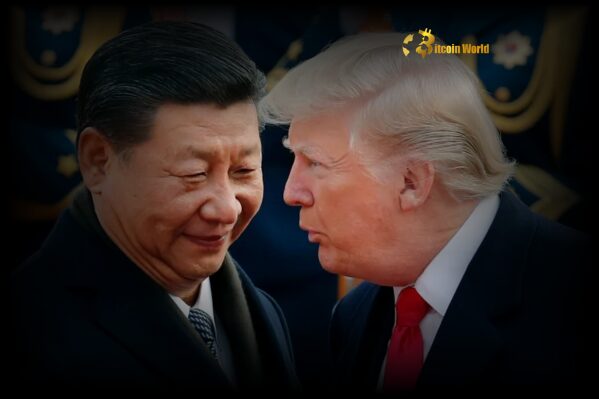BitcoinWorld

Trump China Trade: Shocking Claims of Tariff Violation Resurface
In the ever-evolving landscape of international politics and trade, a significant statement from former U.S. President Donald Trump has once again brought the spotlight back onto Trump China trade relations. According to a report citing on-chain analyst @DeItaone, Trump asserted that China has “totally violated” its tariff agreement with the United States. This claim, while not entirely new in the context of the often-strained relationship between the two economic superpowers, reignites discussions about past trade deals, ongoing tensions, and the potential implications for global markets.
For anyone following global economic developments, particularly those interested in how geopolitical factors can influence financial landscapes, including the volatile world of cryptocurrency, understanding the nuances of the US China tariffs saga is crucial. Let’s dive into what this statement might signify and the history behind these claims.
What Was the Tariff Agreement Trump References?
The statement likely refers to the “Phase One” economic and trade agreement signed in January 2020. This deal was intended to de-escalate the intense trade war that began in 2018 under the Trump administration. At its core, the Phase One agreement involved several key components:
- Increased Purchases: China committed to purchasing at least $200 billion more in U.S. goods and services over 2020 and 2021, compared to 2017 levels. This included specific targets for agricultural products, energy, manufactured goods, and services.
- Intellectual Property Protection: China agreed to strengthen protections for intellectual property, including reducing forced technology transfers.
- Financial Services: The agreement included provisions aimed at opening up China’s financial services market to U.S. firms.
- Currency Practices: Both countries agreed to refrain from competitive devaluation of their currencies.
- Dispute Resolution: A mechanism was established for resolving future disputes.
In return, the U.S. agreed to suspend planned tariff increases and reduce some existing tariffs on Chinese goods, though significant tariffs remained in place on hundreds of billions of dollars worth of imports from China. The intention was to create a more balanced trade relationship and address long-standing grievances regarding trade practices.
Are Claims of Violation Justified? Examining the Evidence
Trump’s claim that China has “totally violated” the agreement centers primarily on the purchasing commitments. Reports and analyses conducted since the agreement was signed have consistently shown that China fell significantly short of the purchasing targets outlined in the deal, particularly in the agricultural and energy sectors, partly due to factors like the COVID-19 pandemic and supply chain disruptions.
For instance, a report by the Peterson Institute for International Economics in early 2022 indicated that China had only met about 62% of its promised purchases of U.S. goods and services through December 2021. While China did increase purchases compared to pre-trade war levels, it did not reach the ambitious targets set in the agreement.
Challenges in Meeting Targets:
- Pandemic Impact: The COVID-19 pandemic severely disrupted global supply chains and reduced demand, making large-scale purchases difficult.
- Economic Slowdown: China’s own economic growth slowed, affecting its import needs.
- Other Suppliers: China continued to diversify its sources for key commodities, not relying solely on the U.S.
- Structural Issues: Critics argue the targets were unrealistic from the start, not fully accounting for market dynamics.
Beyond the purchasing targets, discussions around intellectual property protection and market access have also continued, suggesting that while progress might have been made in some areas, underlying tensions and disagreements persist. Therefore, while the term “totally violated” is strong and characteristic of Trump’s rhetoric, the claim that China did not fully meet the commitments, particularly on purchases, aligns with various economic analyses.
The History of US China Tariffs and the Trade War
To understand the weight of Trump’s recent statement, it’s essential to recall the tumultuous period of the US China tariffs trade war. Initiated in 2018, the conflict saw both countries impose escalating tariffs on billions of dollars worth of each other’s goods. The U.S. administration cited issues like intellectual property theft, forced technology transfer, currency manipulation, and a large bilateral trade deficit as reasons for the tariffs.
This tit-for-tat tariff imposition had significant consequences:
- Increased Costs: U.S. businesses and consumers faced higher costs for imported goods from China.
- Reduced Exports: U.S. exporters, particularly in agriculture, faced retaliatory tariffs from China, harming sales.
- Supply Chain Disruption: Companies began rethinking and restructuring their global supply chains to reduce reliance on China.
- Market Uncertainty: The unpredictable nature of the dispute created significant volatility in global financial markets.
The Phase One agreement was seen as a truce, not a resolution, leaving many core issues unresolved and a substantial portion of the tariffs in place. Trump’s recent comment serves as a reminder that despite the signing of that agreement, the underlying trade tensions and disagreements about its fulfillment remain a significant factor in global economic relations.
What is the Potential Trade War Impact Now?
While Trump is no longer in office, his statements continue to hold sway, particularly as he is a potential candidate for the presidency again. Renewed focus on China’s adherence to trade agreements could signal future policy directions if he were to return to power. More broadly, the persistence of these claims highlights the ongoing friction in global economic relations between the U.S. and China, regardless of who occupies the White House.
The potential trade war impact of such claims, even if made from outside the administration, includes:
- Increased Political Pressure: Puts pressure on the current administration to take a tougher stance on China’s trade practices.
- Business Uncertainty: Creates uncertainty for businesses relying on trade with China, potentially impacting investment and supply chain decisions.
- Market Sensitivity: Financial markets, which are highly sensitive to U.S.-China relations, could react to escalating rhetoric or actions.
- Influence on Future Policy: Shapes the narrative around trade policy ahead of future elections, potentially leading to calls for new tariffs or trade restrictions.
It’s important to note that the current Biden administration has maintained many of the Trump-era tariffs while engaging in its own form of strategic competition with China, focusing on areas like technology, human rights, and national security, alongside trade.
Navigating Complex Economic Relations: Challenges and Insights
The U.S.-China relationship is arguably the most critical bilateral relationship in the world, impacting everything from climate change cooperation to technological development and, of course, economic relations. The challenges in managing this relationship are immense:
| Challenge Area | Description | Insight/Implication |
|---|---|---|
| Trade Imbalance & Practices | Disagreements over market access, subsidies, state-owned enterprises, and intellectual property theft. | Difficult to resolve without significant structural changes in one or both economies; likely to remain a source of friction. |
| Technological Competition | Rivalry in key tech sectors (AI, semiconductors, 5G) leading to restrictions on technology transfer and investment. | Escalates beyond traditional trade disputes into national security concerns; impacts global tech supply chains. |
| Geopolitical Tensions | Disagreements over Taiwan, South China Sea, human rights, etc., spill over into economic interactions. | Makes purely economic negotiations challenging as non-economic factors influence decision-making. |
| Domestic Politics | Both leaders face domestic pressures and political incentives that shape their approach to the bilateral relationship. | Policy can be influenced by political cycles and rhetoric, adding unpredictability. |
For businesses, investors, and even individuals trying to make sense of the global economy, the key insight is that the U.S.-China trade relationship is characterized by deep structural issues and competing national interests that extend far beyond simple tariff levels. Claims like Trump’s, while potentially politically motivated, tap into genuine, unresolved grievances regarding China’s trade behavior and its adherence to agreements.
Conclusion: What Does This Mean Moving Forward?
Donald Trump’s assertion that China “totally violated” the tariff agreement serves as a potent reminder that the trade tensions between the U.S. and China, though perhaps less overtly confrontational than during the peak of the trade war, are far from resolved. The Phase One agreement, intended to ease tensions, appears to be viewed by some, including the former president, as a failure in terms of China’s fulfillment of its commitments.
This situation underscores the fragility of trade agreements between major powers when underlying structural issues and strategic competition persist. While the immediate impact of Trump’s statement might be limited, it contributes to the ongoing narrative surrounding Trump China trade relations and keeps the possibility of future protectionist measures or renewed trade disputes on the table, especially in the context of upcoming political cycles. Keeping an eye on developments in global economic relations, particularly between these two giants, remains essential for understanding potential shifts in international trade policy and their ripple effects across the world economy.
To learn more about the latest global trade trends and their potential impact on financial markets, explore our article on key developments shaping economic relations and future oriented activity.
This post Trump China Trade: Shocking Claims of Tariff Violation Resurface first appeared on BitcoinWorld and is written by Editorial Team





